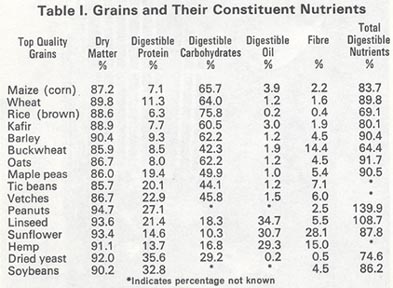
 Pigeon
Racing
Pigeon
Racing
There has probably been more written on feeding than on any other subject related to pigeons. This has always been the most controversial subject. This chapter will give you a general knowledge of what and how to feed. The importance of choosing the right food and feeding in the right way cannot be overemphasized. The fancier who learns to feed correctly will win his share of races. Food gives the elements for proper growth and fuel to nourish the body and produce heat and energy.
What to Feed
Every pigeon fancier should understand the scientific and chemical values of pigeon feed. The food requirements of pigeons come in two main forms: carbohydrates and proteins. Carbohydrates are a compound of carbon with hydrogen and oxygen, such as sugar, starch, and cellulose. Protein is one of a class of nitrogenous compounds, such as albumin, fibrin, and casein, which forms animal tissues. The gelatinous semi-transparent substance obtained from albumin, fibrin or casein is the essential nutritive element of food. To start with, purchase the best-grade feed on the market. There are a number of top-quality commercial feed-mixtures available. After a little experience, you may add different types of grains to increase the quality of the mixture. Make a habit buying the best: do not settle for a lesser quality for the sake of a few dollars. Many fanciers have ruined years of breeding and flying just by using a poor quality of feed. If you find the feed bill is too high, do not sacrifice quality, but cut down on the amount of pigeons you keep. Following is a chart of the most important grains to feed and a break-down of their constituents.

The quality of the grain has proved to be just as important as the varieties given. The major requirement for all mixtures is that every grain must be thoroughly seasoned. No matter how high the quality of the grains you use or how clean the feed is, if the grains have not been thoroughly dried and seasoned, the feed will always cause problems. When unseasoned grains are given, the pigeons' digestive systems become upset, dysentery sets in, the droppings become watery, weight is rapidly lost, and within days the birds most likely will die. The best way to check grains is to pinch and bite them. A good, sound grain will be hard and will break into hard, brittle pieces.
When grains become wet, there are forms of mould which will attack it. Because many moulds are invisible to the naked eye, it is sometimes impossible to detect bad grains, and many illnesses can arise from feeding such mouldy feed. Any feed that is doubtful should be disposed of. Sprouting grains should never be fed, since any grain that has germinated and shows a sprout is poison to pigeons.
All feed should be free of dust and foreign matter. The amount of dirt found in mixtures almost always is a good indicator of the quality of the mixture. Never feed any mixture that contains weevils, or any that has been contaminated by mice or rats. You may say to yourself that you will take a chance on feeding because the feed cost so much. But why run the risk of losing many birds to an epidemic? You can eliminate the risk of contamination if you store the grain correctly.
Storage
Correct storage of feed is another issue
that cannot be ignored. Feed should be kept in a dry, cool, clean, rodent-free
area. Feed, next to water, is the highest source of contamination, so take
considerable precautions in storing it. Good, sound feedbins should be
constructed. Do not make them solid, but have the fronts covered with heavy
wire and fine screening, so that air can circulate through the feed, Air
is very important in keeping the grains from spoiling. Build the bins so
that they are easy to clean and are rodent-proof. If you purchase more
feed than will fit into the bins, it will not hurt the grain to be left
in the original unopened bags. If you have purchased small seeds like linseed
and hemp seed, store them in air-tight gallon jars. All feed and grit should
be stored so that they are completely free from any form of contamination.